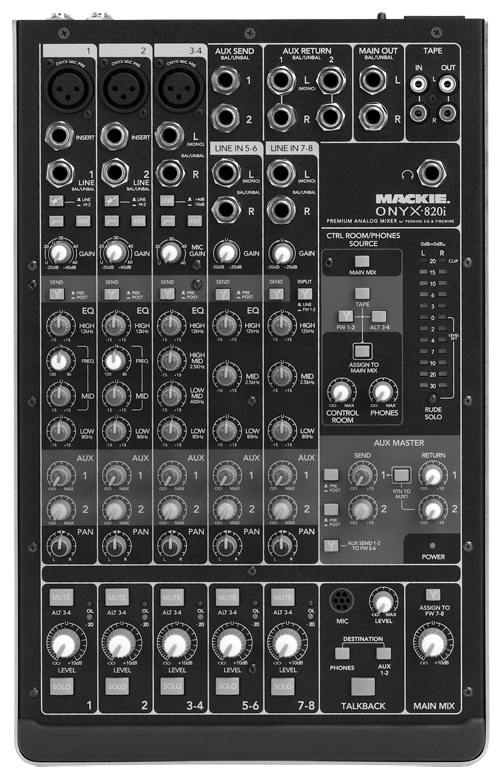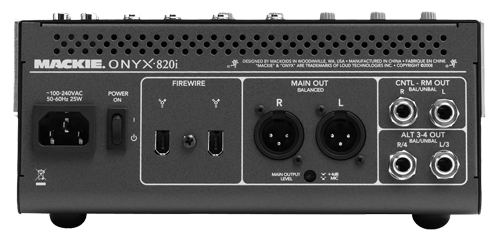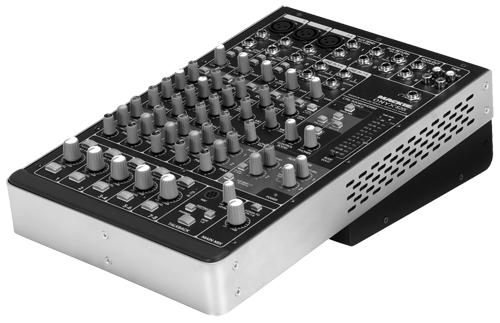by Steve Cunningham
As anyone who’s been around the audio business for more than twenty minutes knows, Mackie has been making some very cool small mixers for a very long time. After all, the original Mackie 1604 is the stuff of legends. The company’s Onyx series of mixers has recently distinguished itself by including a FireWire audio interface on every model, allowing the analog boards to be connected directly to a computer. These particular mixers, referred to as the Onyx-i series, include models with up to 16 input channels and four busses.
This month will look at the latest in the Onyx series: the 820i. This is a terminally cute eight input analog mixer which provides a generous list of features in a form designed to take up minimum real estate on your desktop. However, there’s an added twist to this little mixer’s story, one which particularly piqued my interest. The Mackie 820i mixer is now ProTools compatible, as are its larger siblings.
While these boards have been compatible with other PC and Mac audio editing software for awhile, courtesy of ASIO and Core Audio drivers, the fact that they’re now ProTools M-Powered compatible has surprised a lot of people (possibly including Digidesign itself). At the time of this writing, I’ve not been able to discover whether Mackie was given the necessary driver code by Digidesign, or if they just whumped up their own driver. Either way, it would appear to be a win-win for the end-user.

INSIDE THE CARTON
The Onyx 820i is first and foremost an eight-channel in, stereo out analog mixer, equipped with both mono mic/line channels and stereo line-in channels. The attractive aluminum chassis seems sturdy enough and the little board feels quite substantial, no doubt in part due to Mackie’s use of an internal power supply instead of the customary wall wart one might expect on a mixer of this size. A set of serious rubber feet on the underside of the case, along with the nearly 10 pound heft of the mixer, helped keep it firmly planted in place on my desktop.
The plastic knobs will feel familiar to anyone who has used a Mackie before -- a light touch and just a little wiggle, but smooth nevertheless.
All the input connectors are on the top surface of the board, while the output connectors, FireWire connectors, and AC connector with power switch are located on the back panel. A rackmount kit is available separately as an option.
Channels one and two are mono and include XLR mic inputs, 1/4” line inputs that accept either balanced or unbalanced signals, and an insert on each. Channel 3/4 can function as either a mono mic channel or a stereo line-in channel. Channels 5/6 and 7/8 are stereo line in only and are identical, except for the fact that you can assign the stereo FireWire outputs from your computer directly to Channel 7/8 using a button next to the EQ for 7/8.

SIGNAL PATH
All input channels come with trim controls. For the inputs with mic preamps, these range from -20 dB to +40 dB, more than enough gain for all but perhaps a ribbon microphones. The two line only inputs feature a total of 40 dB of gain, arranged as 20 dB of cut and 20 dB of boost. The three mic channels also have individual 48 V phantom power buttons, important if you want to use both ribbon microphones and condenser microphones at the same time. These three channels also have low-cut filter buttons, each of which engages a high pass filter at 75 Hz within 18 dB per octave slope. Input selector buttons on channels one and two are used to activate a high impedance option for guitars, while the input selector button on channels 3/4 selects between +4 dB and -10 dB input levels.
Next in line is the EQ section which features Mackie’s “Perkins EQ.” Named after the Mackie engineer who developed the circuitry, Mackie claims that this design was inspired by “British” equalizers and trades boost/cut capabilities for an extra 6 dB of control, giving 15 dB of boost and cut. I don’t know about all that, but the EQ does sound good. The two mono channels feature a three band EQ with a sweepable midrange from 100 Hz to 8 kHz. Channel 3/4 gets the standard Mackie eight bus EQ, with four fixed bands at 12 kHz, 2.5 kHz, 400 Hz, and 80 Hz. Channels 5/6 and 7/8 get three bands of fixed EQ, forgoing the 400 Hz band.
At the top of each EQ section is a handy button labeled Send. This is a thoughtful feature that allows you to send your audio from the Onyx into your computer either pre- or post-EQ. In the pre-EQ position, all of the EQ circuitry is removed from the signal path entirely. As nice as it is to have analog EQ (and a Perkins EQ at that), it is good to be able to remove it when you feel like it.
Each channel also features two AUX sends, which can be set to pre- or post-fader via switches in the Master section. However, the switches control all sends simultaneously. Finally, each channel has a pan pot, a solo button and a mute button, and level control on a knob. With this size mixer, one does not expect to get proper faders.
Nor does one expect to get extensive metering capabilities. On the Onyx 820i, a green LED near the level knob begins to flicker when the input signal (which is tapped after the trim control) exceeds -20 dB. A red “OL” LED (which taps the signal post EQ) indicates signal overload. These two LEDs have been stock on Mackie consoles going all the way back to the 1604, and while some may find them insufficient, I’m used to ‘em and they work for me.
THE MASTER SECTION
The Master section, which takes up nearly a third of the mixer’s total width, is home to the usual suspects including two 1/4” jacks for the AUX sends, four more for the two stereo AUX returns and another two for the MAIN outs. All of these are TRS jacks, capable of providing both balanced and unbalanced signal paths. A pair of RCA jacks serve as Tape In and Tape Out, creating a convenient way to connect to a master recorder or external sound source. The MAIN outs are also available on the rear panel as XLRs.
Next is 1/4” headphone out jack, and below that are the source buttons that govern what signals will be delivered to the phones. You can assign the MAIN mix, RCA tape input, FireWire channel 1-2 (straight from your computer), or Alt 3-4 signals to the Control Room outs or the phones. The Alt 3-4 choice is interesting, since the 820i uses another signature Mackie trick -- using a channel mute button to route the signal not into oblivion, but onto a second pair of busses which can be accessed on the rear panel.
Next to the source matrix you’ll find the only proper meter on the console -- a stereo LED ladder meter which clips at +20 dB. It makes good sense, inasmuch as the Onyx has a solid +22 dB of headroom overall. At the bottom of the meters is Mackie’s standard “Rude Solo” LED, without which no Mackie mixer would be complete. And yes, it flashes when any solo button is depressed.
The AUX master section is home to the two AUX Send masters, each with the aforementioned pre-post button. Next to these are the master Return level controls, along with a RTN TO AUX 1 switch to assign the AUX 2 return to go to the AUX 1 send. Flexible, yes? But wait, there’s more... an AUX SEND 1-2 TO FW 5-6 button allows you to route a copy of signals assigned to the AUXES into your computer where they can be processed using plug-ins and brought back into the Onyx via the AUX returns.
Despite all of this flexibility, there will be some that are not pleased by the signal routing that goes into the computer. The output of each channel in the Onyx goes to the computer pre-Insert and pre-EQ, or pre-fader and post-EQ. Ah, but there is an appendix in the PDF manual entitled “Appendix F: Modifications.” It seems that if you’re willing to take your Onyx 820i to a Mackie service center, you can have your board modified so that the signal sent to your computer is, for example, post-fader or post-insert. You can’t say that Mackie doesn’t try to give you what you want.
OFF TO THE COMPUTER
Two FireWire 400 jacks on the rear panel allow the Onyx 820i to send and receive digital audio from your computer. Remember, in no way will the Onyx control your computer, but its built-in FireWire interface does allow you to send your tracks into the computer, having gone through all of the delightful analog goodness described above. And of course, you can bring them back from the Onyx for playback.
These operations require that drivers be installed on your computer. Mackie makes drivers available for both Windows and Macintosh computers; a “universal” driver for the PC actually contains both a SIM and WDM drivers, and requires either Windows Vista or XP SP2. There is no mention on the website of Windows 7 support, at least not yet. On the Mac side, OS X is supported through snow leopard, using a core audio driver. All of these drivers are available from Mackie’s website.
My first test utilized the ASIO driver with Adobe Audition 3 running under XP. After I’d installed the drivers (a simple enough task), I fired up Audition, selected the ASIO driver in preferences, and Audition saw all eight channels immediately. I successfully recorded multiple tracks simultaneously, with no clicks or pops. The Onyx will do 88.2 or 96 kHz sample rates, and you can change the sample rate from within Audition thanks for ASIO. However, the CPU load at higher sample rates goes up proportionately, so I stuck to 44.1 and 48 for eval purposes.
The only real difficulty I had was with the trim control on the microphone inputs. Like many inexpensive mixers I’ve used over the past few years, the taper used in the trim controls on the Onyx is iffy at best. With an Electro-voice RE-20 microphone plugged in, I had to crank the trim control up near its maximum position. Given the RE-20s low output level that didn’t surprise me, but I did have difficulty dialing in the exact level I wanted near the top of the knob’s travel. It seemed that those last few degrees were more sensitive than the rest, and just felt, well, fiddly. But Audition seemed happen enough, and the old RE-20 really did sound good through analog circuitry.
Running ProTools M-Powered 8 was a little different. As you might guess, ProTools M-Powered is not included with the Onyx, nor is it available for sale from Mackie. The M-Powered software carries a price of $249. In addition, you’ll need to get an another driver from Mackie that costs $49.99 and install that in order to make it all work. That little driver is what makes the Universal Driver work with ProTools M-Powered. It turns out that if you’ve ever installed an older version of ProTools, you’ll then have to hunt down and remove any of the old pref files before M-Powered will install successfully.
However, once I’d sorted out those issues on a MacBook Pro, Pro Tools M-Powered started right up. I then took a quick trip to the I/O Setup menu, clicked the Default button for both the inputs and outputs, and M-Powered saw all eight ins and two outs on the Onyx 820i. As with Audition, the old mics do sound nice in ProTools having been through some analog circuitry first.

WRAP UP
As far as I’m concerned, the only iffy item in this Onyx package is its ProTools compatibility. If Mackie wrote their own driver as a result of some clever reverse-engineering, then it’s possible that Avid (Digi’s parent) could sue, in which case that compatibility could be lost.
Yeah, and so what. The Onyx is a very competent little analog mixer at an entry level price. Its built-in interface is compatible with most popular editing software, so what’s the big deal? From an audio standpoint, it’s a nice-sounding little board, with mic preamps whose trim controls are a bit fiddly, and which will generate a little noise if you push the level hard. But the EQ sounds good, the signal path is otherwise clean, and the build quality seems very good. All in all, it’s a nice little entry-level board with some heavy bells and whistles. Steve sez check it out.
The Mackie Onyx 820i Firewire mixer carries a suggested US retail price of $649.99, although street prices tend to be just under $500. For more information worldwide, visit www.mackie.com.
♦

